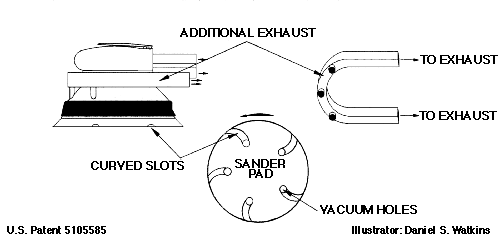Control of Wood Dust From Random Orbital Hand Sanders
1996
DHHS (NIOSH) Publication Number 96-125
Hazard
Random orbital (rotating) hand sanders have been found to create significant amounts of wood dust. Workers exposed to wood dusts have experienced a variety of adverse health effects such as eye and skin irritation, allergy, reduced lung function, asthma, and nasal cancer. Therefore, the National Institute for Occupational Safety and Health* (NIOSH) recommends limiting wood dust exposures to prevent these health problems.
Controls
NIOSH researchers found that wood dust created by random orbital hand sanders is often poorly controlled. To address this problem, researchers designed and tested a new control system for these hand sanders that significantly reduced dust emissions.
Additional Exhaust System
Random orbital hand sanders are widely used in woodworking applications. The dust generated by these tools is sometimes controlled by an aspirator in combination with a perforated sanding pad. The aspirator creates a vacuum to draw wood dust up through holes in the sanding pad. It was found that, in spite of this control, large amounts of wood dust were still emitted into the workroom. A new control system that uses Additional Exhaust and a Slotted Sanding Pad was implemented to increase dust control. (See ILLUSTRATION) The increased suction of the additional exhaust alone causes the sanding pad to be pulled to the work surface making the tool difficult to use. To alleviate this problem, curved slots are cut into the sanding pad. This relieves the pressure caused by the extra suction and provides additional dust control at the pad periphery. The new dust control system reduces dust emissions by approximately 90 percent compared with the currently used aspirator controlled sander. The new sander does not interfere with the operator, requires no special maintenance and is inexpensive to operate. This dust control device is not currently commercially available. Call NIOSH for more information.
*NIOSH is the Federal agency responsible for conducting research and making recommendations for preventing work-related illness and injuries. HAZARD CONTROLS are based on research studies that show reduced worker exposure to hazardous agents or activities.
Illustration: Additional Exhaust and Slotted Sanding Pad for Hand Sanders
A technical article Control of Wood Dust from Rotational Hand-Held Sanders, Appl Occup Environ Hyg 7(4):263 270(1992), has been published on this subject. Also, a videotape on this topic New Control for Use with Rotating Hand Sanders, Tape #207, five minutes, may be borrowed free of charge.
This document is one in a series of seven HAZARD CONTROLS concerning wood dust control techniques listed below that are available free upon request from NIOSH:
- HC4 Control of Wood Dust from Horizontal Belt Sanders
- HC5 Control of Wood Dust from Shapers
- HC6 Control of Wood Dust from Automated Routers
- HC7 Control of Wood Dust from Large Diameter Disc Sanders
- HC8 Control of Wood Dust from Random Orbital Hand Sanders
- HC9 Control of Wood Dust from Orbital Hand Sanders
- HC10 Control of Wood Dust from Table Saws
Acknowledgments
The principal contributors to this HAZARD CONTROLS are Jennifer L. Topmiller, Division of Physical Sciences and Engineering, and Jerome P. Flesch, Education and Information Division, NIOSH.
This document is in the public domain and may be freely copied or reprinted. NIOSH encourages all readers of this HAZARD CONTROLS to make it available to all interested employers and workers.
Control of Wood Dust From Random Orbital Hand Sanders [PDF - 153 KB]
- Page last reviewed: June 6, 2014
- Page last updated: June 6, 2014
- Content source:
- National Institute for Occupational Safety and Health Education and Information Division


 ShareCompartir
ShareCompartir